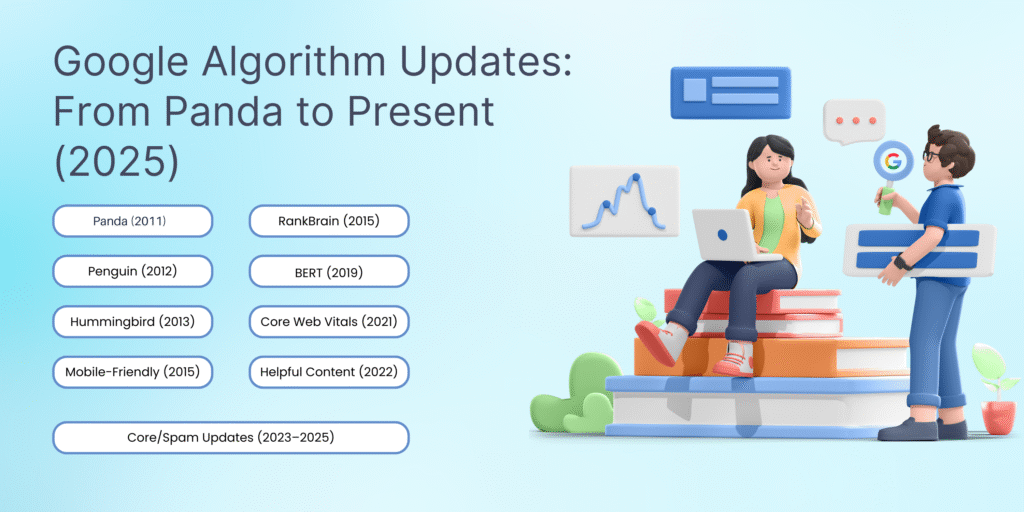The algorithm powers the search engine at Google and the ultimate goal of the algorithm is to provide good quality and qualitative results to the core of the search engine users throughout the globe. As an SEO expert and an owner of a given site, it is necessary to be aware of the changes in algorithm by Google to ensure that one will not be forgotten in the search results.
- What is a Google Algorithm?
-
Major Google Algorithm Updates (Time-to-Time Evolution)
- 1. Google Panda (February 2011)
- 2. Google Penguin (April 2012)
- 3. Google Hummingbird (August 2013)
- 4. Google Mobile-Friendly Update (April 2015) (aka "Mobilegeddon")
- 5. Google RankBrain (October 2015)
- 6. Google BERT (October 2019)
- 7. Core Web Vitals & Page Experience Update (June 2021)
- 8. Helpful Content Update (August 2022)
- 9. Spam Updates & Core Updates (Ongoing)
- How to Stay Ahead of Google Algorithm Changes
- Final Thoughts
In this blog, we would guide you through the sequence of major Google Algorithm updates, how they developed in the last successive years and what they entail in relation to current SEO.
What is a Google Algorithm?
Google algorithm is a multiple-faceted mechanism containing series of steps that Google uses to pull information that is within its search index and returns the most appropriate data in response to a query. These algorithms consider hundreds of ranking factors such as keywords, backlinks, page speed, content quality, mobile usability and user behavior.
With time, these algorithms are changed by Google in order to enhance searching, decrease the level of spam, and support the websites that bring true value to users.
Major Google Algorithm Updates (Time-to-Time Evolution)
1. Google Panda (February 2011)
- Purpose: To penalize low-quality, thin, or duplicate content.
- Impact: Websites with poor-quality content or high ad-to-content ratios saw ranking drops.
- SEO Tip: Focus on creating unique, helpful, and in-depth content.
2. Google Penguin (April 2012)
- Purpose: To target spammy backlinks and keyword stuffing.
- Impact: Many websites using manipulative link-building tactics were penalized.
- SEO Tip: Build natural backlinks and avoid keyword stuffing.
3. Google Hummingbird (August 2013)
- Purpose: Better understand search intent and natural language.
- Impact: Improved semantic search, helping users get more accurate results.
- SEO Tip: Optimize for topic relevance and user intent, not just keywords.
4. Google Mobile-Friendly Update (April 2015) (aka “Mobilegeddon”)
- Purpose: Boost mobile-friendly websites in search results.
- Impact: Mobile usability became a major ranking factor.
- SEO Tip: Ensure your site is responsive and performs well on mobile devices.
5. Google RankBrain (October 2015)
- Purpose: Uses machine learning to understand and rank search results.
- Impact: Search results became more user-intent focused.
- SEO Tip: Create content that answers questions and solves problems.
6. Google BERT (October 2019)
- Purpose: Understand the context of words in a sentence using NLP (Natural Language Processing).
- Impact: Better understanding of long-tail and conversational queries.
- SEO Tip: Write naturally and focus on clarity and context.
7. Core Web Vitals & Page Experience Update (June 2021)
- Purpose: Measure user experience with metrics like loading speed, interactivity, and visual stability.
- Impact: UX signals started influencing rankings.
- SEO Tip: Improve your site speed, mobile experience, and layout stability.
8. Helpful Content Update (August 2022)
- Purpose: Promote content created for humans, not search engines.
- Impact: Websites with AI-generated or unhelpful content lost rankings.
- SEO Tip: Focus on providing genuine value to readers with human-first content.
9. Spam Updates & Core Updates (Ongoing)
- Google regularly rolls out Core Algorithm Updates (several times a year) and Spam Updates to maintain quality search results.
- SEO Tip: Keep your site trustworthy, well-structured, and updated.
How to Stay Ahead of Google Algorithm Changes
- Follow Official Google Updates: Stay informed via Google Search Central Blog.
- Monitor Your SEO Metrics: Use tools like Google Search Console, SEMrush, or Ahrefs.
- Focus on E-E-A-T: Experience, Expertise, Authoritativeness, and Trustworthiness are key.
- Write for Humans, Optimize for Search Engines: Balance readability and SEO best practices.
- Update Old Content: Keep your content fresh and relevant to maintain rankings.
Final Thoughts
Google’s algorithms will continue to evolve as search behaviors, technology, and content trends change. Instead of chasing every update, build a strong foundation based on quality content, user experience, and ethical SEO practices. That way, no matter how the algorithm changes, your website will remain resilient and continue to grow in visibility.
